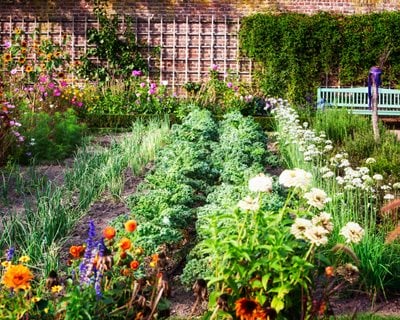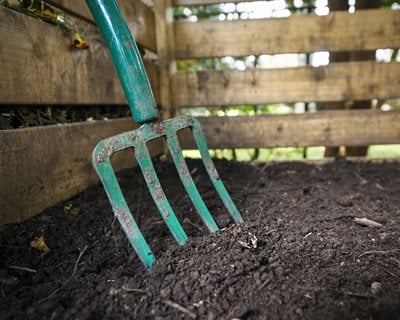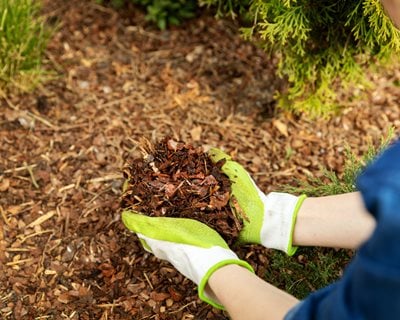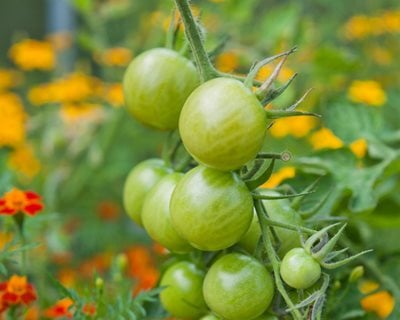10 Keys to Starting an Organic Garden
Use natural methods to grow plants in your garden Published 9/29/2022
Photo by: ifiStudio / Shutterstock.
As gardeners become more aware of the harmful effects of synthetic fertilizers and pest controls, more are turning to natural organic gardening methods. Organic gardening is easier on the environment and results in healthier plants.
What is organic gardening and how can you employ these techniques in your own yard? Here are some of the basics to creating a successful organic garden.
WHAT IS ORGANIC GARDENING?
Organic gardening is a holistic approach to gardening, using natural solutions when it comes to soil amendments, fertilizers, and pest and disease controls. This method of gardening cultivates a sustainable ecosystem that nourishes plants, beneficial insects, and soil microbes. Synthetic remedies that may be harmful to humans, animals, and the environment are shunned. Organic gardening methods are more eco-friendly and sustainable than non-organic methods.
BENEFITS OF ORGANIC GARDENING
The benefits of organic gardening include:
- A garden environment that is safe for humans, pets, and wildlife
- Improved soil health, which results in healthier plants.
- Conserves water, leading to lower water bills.
- Eating clean food that is healthier, tastier, and more nutritious.
- Growing your own organic food may save you money at the grocery store.
- Improved mental and physical health by tilling the soil, hauling compost, pulling weeds, harvesting crops, and other manual garden chores.
1. SOIL HEALTH

Photo by: Sharon Kingston / Shutterstock.
In organic gardening, soil is the foundation of a productive garden and is regarded as a living ecosystem rather than an inert growing medium. Healthy soil has many benefits, including better water retention, helping to control runoff and reducing water usage.
Native soils usually need to be amended with organic matter to support plants and soil microbes. Organic amendments include compost, aged manure, fallen leaves, grass clippings, straw, and shredded bark. Natural inorganic materials such as perlite, sand, vermiculite, and pumice can be added to improve drainage. By adding the right ingredients, a barren landscape can be transformed into a lush garden.
But, before amending the soil, it’s crucial to determine what soil type you have and what it needs.
Examine soil texture first. If it feels gritty, it’s comprised mostly of sand. Soil that is sticky when wet and hard when dry is comprised mainly of clay. A fine powdery texture indicates a silty soil. Healthy soil will be dark and crumbly, and full of life-giving microbes that improve soil structure, filter out urban pollutants, fix nitrogen in the soil, facilitate the uptake of nutrients, stimulate plant growth, and help prevent diseases.
Next, have your soil analyzed to determine the pH level and any nutrient deficits. A soil test can be done at a local extension service or through a private company. Soil pH refers to the acidity or alkalinity of the soil, which affects a plant’s ability to absorb nutrients. The pH level can be adjusted organically with natural rock-based products. Agricultural lime boosts soil alkalinity, while ammonium nitrate increases soil acidity.
2. COMPOSTING

Photo by: Elena Elisseeva / Shutterstock.
Homemade compost is one of the best soil amendments, as it contains essential nutrients, helps with soil aeration, and is teeming with beneficial soil organisms. It’s easy to create your own compost pile at home by using organic materials found around your yard and from your kitchen. You can also buy finished compost from a local garden center or soil company, which will carry a range of different mixes such as all-purpose compost, mushroom compost, manure compost, and worm castings.
Another method of composting is vermicomposting, using red worms to break down kitchen scraps, paper, cardboard, egg shells, and used coffee grounds into worm castings.
Find more on how to make and apply compost.
3. FERTILIZING
In order to grow their best, plants need primary nutrients of nitrogen, phosphorus, and potassium, along with secondary nutrients, trace elements, and minerals. There are many types of organic fertilizers with a range of nutrient contents and uses.
- Dry fertilizers are slower acting and mixed into the soil at planting time. These can be plant-based such as cottonseed meal, kelp meal, alfalfa meal, and wood ash. Animal-based fertilizers include bone meal, blood meal, and fish meal. Natural inorganic supplements include rock phosphate or greensand. There are also many ready-made fertilizer blends.
- Water-soluble fertilizers are quicker acting and applied throughout the growing season. These can be made from fish emulsion, kelp, or seaweed extract. Homemade liquid fertilizers can be made from compost or manure, which are steeped in water and brewed into tea. Liquid fertilizers can be watered into the soil or used as a foliar spray.
- Animal-based manures contain nutrients and improve soil structure. These can be mixed into the soil before planting and include horse manure, chicken manure, and cow or steer manure. Earthworm castings are a rich source of the three essential nutrients.
- Before using fertilizers, test your soil for pH levels and to find out what nutrients may be lacking. For each type of fertilizer you plan on using, research the nutritional content, make sure it’s the right fertilizer for the right plant at the right time, and use according to instructions.
Find more on organic garden fertilizers.
4. MULCHING

Photo by: ronstik / Shutterstock.
Mulching involves adding a layer of organic or inorganic matter on top of the soil to suppress weeds, cool plant roots, and retain moisture. Organic mulch improves soil structure, provides nutrients, helps to stem erosion, reduces water usage, and can be aesthetically pleasing.
Types of organic mulch include compost, shredded or chipped bark, straw, shredded leaves, conifer needles, and grass clippings. Natural inorganic mulches include gravel or crushed stone. Ground cover plants can be used as a living mulch. Bark is typically applied around trees and shrubs, while straw is a common mulch for vegetable beds. Other mulches are used in a variety of ways.
Read more on mulching.
5. NATURAL PEST CONTROLS
Controlling or eradicating pests is one of the biggest gardening challenges. Garden pests can cause serious damage to the garden, mainly by feeding on plants, which can weaken or kill plants and introduce diseases. Pests include mammals such as deer, moles, or chipmunks, though most pests are some type of insect. Not all insects are bad; in fact, most are harmless, or can even be beneficial to your garden.
Organic gardeners use natural pest controls rather than chemical pesticides or insecticides. The goal is to not completely eliminate pests, but to control them enough so they don’t cause serious damage to plants.
After properly identifying the pest you are targeting, a number of organic methods can be used, including:
- Selective pruning: Cut out affected areas on plants and discard in the trash.
- Water: Gently spray plants with water to dislodge pests.
- Attract beneficial insects: Enlist natural predators such as lacewings, lady bugs and parasitic wasps to help control pests.
- Organic products: Use products such as diatomaceous earth, horticultural oil, insecticidal soaps, insect traps, or homemade remedies such as garlic or chili pepper sprays.
- Barriers: Row covers can be placed over raised beds or vegetable rows to keep out pests.
- Pest-resistant plant varieties: Some plants are more resistant to pests than others; include these varieties in your garden.
- Keep plants healthy: Plants that are healthy are more resistant to pests.
Read more on organic remedies for garden pests and diseases.
6. SELECTING ORGANIC SEEDS AND PLANTS
Another aspect of organic gardening is the use of organic seeds and plants. When choosing organic varieties, look for the designation “Certified Organic,” which means they meet strict quality standards in accordance with the USDA National Organic Program. Because of the more labor-intensive methods of producing organic seeds and plants, they tend to be more expensive and have a limited selection.
7. CROP ROTATION
A common practice in growing organic food is crop rotation. This involves growing different unrelated crops in the same area from year to year. Growing the same crop in the same spot over a period of years can lead to soil depletion, an increase in pest and disease problems, weakened plants, and lower yields.
The best way to rotate crops is to group them by family since related vegetables will have similar problems. For example, avoid planting potatoes, peppers, and eggplant in the same spot as you grew tomatoes the previous year, as they all belong to the nightshade family. Legumes such as peas and beans fix nitrogen into the soil, which will benefit next year’s crop grown in the same spot.
8. COMPANION PLANTING

Photo by: Joanna Tkaczuk / Shutterstock.
Companion planting takes advantage of the beneficial relationships between certain plants. This organic gardening technique is primarily used in vegetable gardens. For example, one plant may deter garden pests that harm another plant, while in return, that other plant may attract pollinators or enhance the soil. Conversely, some plant combinations can result in poor performance.
Read more on companion planting.
9. BENEFICIAL INSECTS
Though gardeners often think of insects as pests, most are harmless and some are even beneficial to your plants. Insects such as bees, butterflies, moths and flies are essential to pollinating plants, which enhances plant diversity and increases crop yields. Other insects including lady bugs, lacewings, praying mantis, and parasitic wasps feed on insect pests and their larvae.
Attract beneficial insects to your yard by including plants they like and provide food, water, shelter, and places for these insects to reproduce. Delay fall cleanup until spring to avoid disturbing beneficial insects that overwinter in plant stems, bark, and the soil. Avoid the use of chemical insecticides and pesticides, which can harm beneficial insects as well as pests.
Read more on beneficial insects.
10. AVOID SYNTHETIC FERTILIZERS, PESTICIDES, AND HERBICIDES
Organic gardening involves the avoidance of chemical fertilizers, herbicides, pesticides, and insecticides, which can be harmful to humans, pets, and wildlife. Some of the adverse effects of synthetic remedies include:
- Chemical pesticides can be harmful to beneficial insects
- Synthetic fertilizers are more likely to burn plant roots
- Synthetic fertilizers can also create a buildup of salts in the soil which can stunt plant's growth
- Beneficial microbes can be adversely impacted, disrupting the soil ecosystem
- Synthetic remedies can accumulate in the soil and leach into groundwater sources
- Pets and wildlife may be sickened or killed by exposure to toxic chemicals
- Chemical fertilizers and pesticides contribute to global greenhouse emissions
- Some chemical herbicides may cause cancer or other diseases in humans
- Synthetic chemicals can be toxic if used on edible crops





